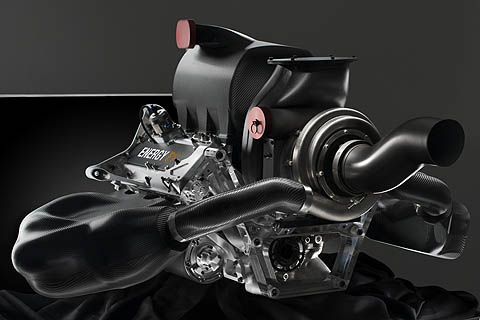


21/06/2013
NEWS STORY
 |
Renault has unveiled the 1.6 litre V6 Turbo engine that will be used by Red Bull, Lotus, Toro Rosso and Caterham in 2014.
In 2014, Formula One enters a new era when, after three years of planning and development, the most significant technical change to hit the sport in more than two decades is introduced.
Engine regulations form the major part of the coming revolution, with the introduction of a new generation of power units that combine a 1.6 litre V6 turbocharged engine with energy recovery systems that will dramatically increase efficiency by harvesting energy dissipated as heat in the exhaust or brakes.
The maximum power of the new power unit will exceed the output of current V8 F1 engines however fuel efficiency will be radically improved. With only 100kg permitted for the race, the new units will use 35% less fuel than their predecessors.
"From 2014 we will bring engines to the fore and redress the balance in F1. An engine is the heart of a car, from next year it returns to the heart of our sport," said Alain Prost, Renault ambassador and four-times Formula One World Champion.
For several years, Renault has used its racing know-how to develop fuel efficient engines for its road cars, notably its Energy range. The objectives were clear: maintain or improve driving pleasure, vitality and acceleration with downsized engines to achieve lower fuel consumption and CO2 emissions.
Renault has employed these principles in developing the F1 power unit, creating a complete, and genuine, circular development process between road and track. For these reasons, Renault has named the F1 Power Unit series 'Energy F1'; clearly illustrating that the F1 Power Unit shares the same DNA as its road-going cousins.
"From next year, one of the greatest challenges in F1 will be to maximize energy efficiency and fuel economy while maintaining the power output and performance expected of F1 cars," said Jean-Michel Jalinier, President of Renault Sport F1. "Renault has pioneered this technology in its road car engine range with the Energy series. Naming the Power Unit Energy F1 creates an unbroken range, from the Clio through to our competition department."
As for fears about the sound of the new generation of engines, Rob White, Deputy Managing Director (technical), said: ''The sound of the engine is the sum of three principal components, exhaust, intake and mechanical noise. On fired engines, exhaust noise dominates, but the other two sources are not trivial and would be loud if the exhaust noise was suppressed and contribute to the perceived sound of the engines in the car.
''All three sources are still present on the V6. At the outset, there is more energy in each combustion event but there are fewer cylinders turning at lower speed and both intake and exhaust noise are attenuated by the turbo. Overall, the sound pressure level (so the perceived volume) is lower and the nature of the sound reflects the new architecture.
''The car will still accelerate and decelerate rapidly, with instant gearshifts. The engines remain high revving, ultra high output competition engines. Fundamentally the engine noise will still be loud. It will wake you from sleep, and circuit neighbours will still complain. The engine noise is just a turbocharged noise rather than a normally aspirated noise: you can just hear the turbo when the driver lifts off the throttle and the engine speed drops.
''I am sure some people will be nostalgic for the sound of engines from previous eras," he concluded, "including the preceding V8, but the sound of the new generation Power Units is just different. It's like asking whether you like Motorhead or AC/DC. Ultimately it is a matter of personal taste. Both in concert are still pretty loud.''
Timeline
January 2012: After seven months of design and build, the first cylinder of the V6 is tested on the single-cylinder dyno in Viry. This extremely accurate dyno enables micro analysis of the combustion event and fuel consumption in one cylinder, facilitating iterative design enhancements that can ultimately be scaled up to all six cylinders without unnecessary time or economic loss.
June 2012: After six months' testing on the single cylinder dyno, the first full V6 prototype is tested on the full dyno. Initial tests focused on achieving reliability over short distances before increasing the number of kilometres completed. The first power curve – or the complete range of operating speeds – was achieved at the end of August.
February 2013: The MGU-H and MGU-K energy recovery systems are assembled and tested on the dynos alongside the V6 internal combustion engine. The technical regulations demand radically advanced and complex design solutions so the design and manufacture stage lasted considerably longer than the design phase for the thermal engine.
June 2013: The first race-intent Power Unit and Energy Recovery System is run on the dyno for the first time. Two years of planning and preparation are reconciled, and the complete unit – more or less in its final stages – enters the final stage of optimization before its eventual track test.
Early January 2014: The Power Units will be installed into the partner teams ready for fire up and launch.
Mid January 2014: The first 2014 chassis will hit the track.
March 2014: First Grand Prix.
Hear a short (14s) preview of how the engine will sound, here.
and
Check out our gallery, here.